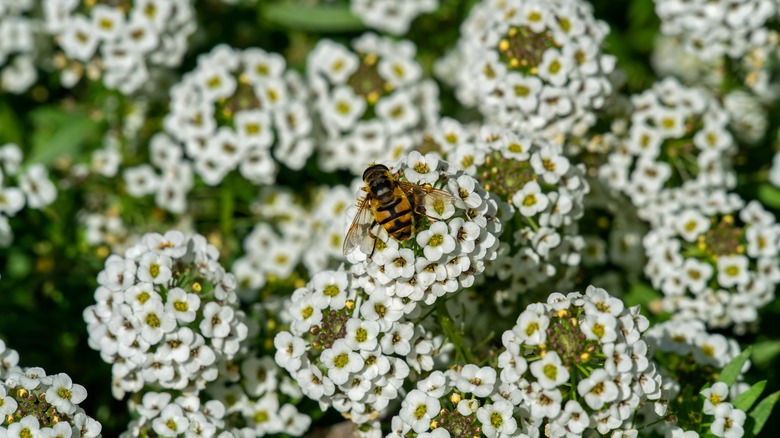Petunias are among the most popular annuals to plant thanks to their wide range of color options and their versatile uses. They can be the main attraction in a container or a filler in a long bed. For many gardeners, the question isn’t whether to plant petunias, it’s what flowers to plant alongside them. While there are many great options for companion plants, it’s hard to beat the aromatic benefits of sweet alyssum (Lobularia maritima).
Part of the beauty of gardening is that you can tailor your plant selection to your priorities and needs. For those whose key goal is to help their yard look and smell as lovely as possible, the combination of petunias and sweet alyssum is ideal. Alyssum gives off a pleasant scent similar to honey, making it a popular option near doorways and windows, along pathways, or close to outdoor sitting areas. This scent combined with the sweet smell of petunias is a winning mix for a delicious and beautiful garden.
How alyssum complements petunias

Alyssum grows low to the ground, which creates the perfect visual complement to petunias that typically grow in a bushy formation. Since there are so many color varieties of both petunias and sweet alyssum, it’s easy to find combinations that complement one another. Because they are tolerant to frost and can grow well in containers or directly in the ground, perennial alyssum plants offer the ideal mix of flexibility and durability to complement annual petunias. Since petunias thrive in hotter months while alyssum dies back and vice versa, combining these two is a great way to sustain a colorful garden for months on end.
In addition, sweet alyssum and petunias make great companion plants because they favor similar growing conditions. They both need to be watered once a week. Petunias need enough to soak the soil 6 to 8 inches deep and should be watered again when the top couple inches are dry. Alyssums need an inch per week while allowing for drainage and dry soil between waterings. When choosing a location, ensure that the plants will see at least 5 hours of direct sunlight each day. Alyssum can tolerate a bit less direct sun, but petunias thrive in full sun. Finally, sweet alyssum is an excellent flower to grow near your petunias to attract butterflies, birds, and important pollinators. Their sweet scent isn’t only beneficial to humans! Sweet alyssum provides nectar and food for pollinators and songbirds, benefitting your entire garden ecosystem.
Tips for growing alyssum with petunias
Sweet alyssum flowers for a long time, especially in mild climates, and is hardy as a perennial in USDA zones 9 to 11. In cooler zones, they can be planted as annuals in early spring or even fall. If you live in zone 9, 10, or 11, however, always sow alyssum seeds in the early spring. These plants grow quickly and you’ll see flowers in no time, but keep in mind that they will likely slow down during very warm months. Have no fear: their flowering beauty will pick up again in early fall.
To grow your petunias and alyssum alongside one another, first decide where your petunias will go. In zones 9, 10, and 11, petunias may be grown as perennials, but they are usually used as an annual flower. Choose a location in full sun for maximum flowering potential, and be sure to wait until the risk of frost has passed before planting. Petunias tolerate heat well and can grow in buckets, in beds, or in the ground. In the spring, consider your ideal garden design, leave a spot for your petunias, and seed your sweet alyssum in surrounding areas. Sweet alyssum pairs nicely with hibiscus as well, so you could add these flowers for even more color and interest. Whether you use sweet alyssum around the edges, as a ground cover, or as a filler between other plants, this combination is sure to impress.
